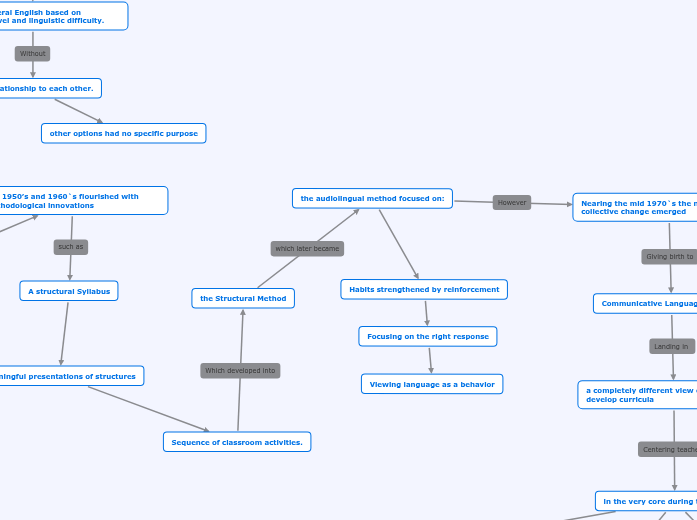AUDIOLINGUAL METHOD
DESIGN
THE ROLE OF INSTRUCTIONAL
MATERIALS:
The recorder and the audiovisual equipment
are the central role in the audiolingual course
The text book is not used in the elementary phases
Help the teacher developing language proficiency
on the student
Teacher- oriented
TEACHER ROLES:
Model of the target language
Monitors and controls the learner's performance
Controls the process of learnig
Central and active coach
LEARNER ROLES:
They can be directed by skilled training tecniques
They do not initiate the interaction
Reactive role
TYPES OF LEARNING
AND TEACHING ACTIVITIES
Drills:Repetition,Inflection, replacement,restatement, completion, transposition, expansion, contraction, transformation, integration rejoinder, restoration.
Diologues:Used for repetition and memorization.
SYLLABUS:
The language may be present entirely orally at first, then written presentations.
Lexical syllabus of basic vocabulary
Analysis of the differences between the native language and the target language
Contains items of phonology, morphology and syntax of the language.
OBEJTIVES:
Long-range objectives:
Language is primarily speech in Audiolingual theory
Language of the native speaker. Knowledge of a second language.
Short-Range Objectives:
The hability to reproduce these symbols in writing
Recognition of speech symbols
Accurate pronunciation
Listening comprehension
PROCEDURE
As the primary used is oral skills, the instruction are immediate and accurate during the procees:
Follow up activities in a language laboratory or vocabulary
May be introduced: Textbooks, reading and writing activities.
Key structures are selected and used for pattern drills.
Dialogues are adapted and then acted out.
Extensive oral instruction is required where the target language is used
APPROACH
Theory of learning
1.Foreing languge is a process of mechanical habit formation( Correct responses and minimizing mistakes)
2. Aural- oral is needed for the development of other languages skills.
3. Analogy provides a better foundation for language learning than analysis.
4. Teaching a language involves teaching aspects of the cultural system who speak the language
LEARNIG PRINCIPLES:
The behaviorist believe that humans are organism capable of learning many behaviors, it depends on three elements:
1. STIMULUS (bring out behavior)
2.RESPONSE (triggered by stimulus)
3. REINFORCEMENT (marks the response as being appropriate or not, which is vital in the learnig process)
Theory of language
Secundarily: Writing
Primarily: Speaking
Structural linguistcs:Language is oral, speech is language. Speech had a priority in laguage teaching
Positivism and Empiricism development of a new intrest in phonethics, phonology, morphology and sintax
Audioligualism (1950) derived from structural linguistics









